Steve Yanoviak is a postdoctoral research associate at the Evergreen State College in Olympia, Wash., and he currently resides in Costa Rica nine months of the year, researching rain forest canopy insect diversity in the Monteverde cloud forest. He has been studying the ecology of tropical insects for over seven years.

Sunday, 27 Aug 2000
MONTEVERDE, Costa Rica
I have a habit of not working in the forest on Sundays, so I will take this time to tell you a little about my surroundings and what I am doing here in northwest Costa Rica.
I live in the “town” of Monteverde. It does not look like a stereotypical town in the U.S. by any means; there is no Wal-Mart, no traffic light, and the unpaved road is shared by cars, horses, motorcycles, ox-drawn carts, and tour buses. Most of the homes are nestled in the woods, and people visit their neighbors via a series of trails through the forest. This community was established by some pioneering Quakers around 50 years ago. They came here in search of a peaceful place to set up dairy farming operations and to live in harmony with the surrounding forest. The founding Quakers recognized the value of the watershed, and they protected that essential resource by creating the Monteverde Cloud Forest Reserve.
The Reserve is a huge tract of largely undisturbed cloud forest covering the top of the mountain (part of the Cordillera de Tilarán) from about 1,500 to 1,800 meters in elevation. The forest is incredibly lush, and harbors several charismatic species, including resplendent quetzals and big cats. Each year, about 50,000 tourists come here to walk the trails in the forest, and tourism drives the local economy. The forest is called a “cloud” forest because most of the moisture that feeds the plants comes in the form of wind-driven mist and fog. During most of the year, trade winds pick up moisture from the Atlantic and carry it westward across Costa Rica to the Pacific. The mountains in the Monteverde area force the winds to a higher altitude, and the lower pressure and temperature causes the moisture to condense into clouds. This effect is called “adiabatic cooling” and is critical to the persistence of the forest. The trees, and the many other plants living on trees, collectively act like a big sponge, extracting moisture as the clouds blow through. Recent studies by Dr. Alan Pounds indicate that global warming is causing the cloud bank to rise in altitude. The rising cloud bank means that less moisture hits the mountain, and this will obviously have negative effects on the native vegetation over the long term.
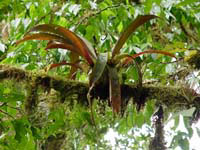
An epiphytic bromeliad.
When you walk in the cloud forest, one of the first things you notice is the great abundance of epiphytes — plants that live on top of other plants. Bromeliads, orchids, and ferns are some common examples, and they are all abundant (along with mosses and even some woody plants) on the branches and trunks of trees in the Reserve. My colleague, Dr. Nalini Nadkarni, has been studying the ecology of epiphytes in this forest for nearly 20 years. To mimic the effect of a rising cloud bank on these plants, Nalini moved some of them from the Reserve to lower elevations where there is less moisture. Not surprisingly, most of the transplanted epiphytes died in the drier environment. This result suggests that global warming will gradually, but dramatically, reduce the abundance and diversity of epiphytes in this and other forests.
I am working here with Nalini to document the insects and other invertebrates that live in association with epiphytes. Specifically, we want to know if epiphytes in old, undisturbed forests (400+ years in age) contain more invertebrate species than epiphytes in young (40-year-old) forests that were once pastures. To do this, I climb trees in each forest type and collect small quantities of epiphytes. Each epiphyte clump is then carried to the lab, where I use a special apparatus called a Tullgren funnel to extract the animals. Most of the critters that come out of the plants are very small — mites and tiny insects only a millimeter or two in length — so my assistants and I must then spend many hours counting and sorting the specimens under a microscope. (To see images of some of the amazing mites we find, check out this site.)
Tropical forests are packed with interesting plants and animals, and I will certainly tell you more about what I see, hear, feel (and maybe even smell) in the forest over the next several days. But I also see a lot of wonderful things in my house and yard …
I live in a small house in a Monteverde neighborhood called Bajo del Tigre. This is rugged country, and like most houses in the area, mine is precariously perched on a cliff above the Guacimal River. I awoke at 5:30 this morning to diffuse light pouring in the window of my loft and the sound of black-breasted wood-quail calling in the adjacent forest. Their call is surprisingly similar to a car alarm. I also heard the calls of brown jays and keel-billed toucans coming from trees near the house. The call of a keel-billed toucan sounds more like a frog than a bird. To me, it sounds like someone running their thumb along the teeth of a huge plastic comb, like the ones we used to get at the fair when I was a kid. (I’ll never understand what motivated people to make those useless things!) I glanced out the window just in time to see three toucans fly across the ravine behind my house. These are crow-sized birds, mostly black with a red butt and conspicuous multi-colored bill — obvious inspiration for Toucan Sam of Fruit Loops cereal. I never get tired of seeing them. A friend once noted that a flying toucan resembles a bird pushing a banana through the sky. This is perhaps the most accurate description I have ever heard. Toucans flap their wings vigorously for a few seconds to gain altitude, then their bill pulls them downward as they glide for a few seconds, and the cycle is repeated again and again.

A common Monteverde scorpion.
After a breakfast of fresh local eggs fried in Monteverde butter and coffee that is processed just down the road, I sat on my couch to read. Much to my surprise, a scorpion fell from the ceiling and nearly landed on my open book. Scorpions are very common here, and I typically shoo two or three out of my house every day during the dry season months. I looked up to see what caused this particular one to fall (scorpions are pretty good climbers), and I was shocked to see that the wall behind me was literally covered with swarming army ants. Organized chaos is perhaps the best way to describe such a raid. Thousands of dark brown worker ants, each about a centimeter long and some with long, sickle-shaped mandibles, fanned out up the wall as another group spread across the floor. They left no space unexplored, and a great variety of cockroaches, beetles, and more scorpions fled from the cracks in my floor to escape their advance. Most efforts to flee were successful, but at least two scorpions were stung to death, dismembered, and carted away in pieces by remarkably organized groups of ants. The swarm raid passed after about 30 minutes, leaving behind a dense column of ants 10 cm wide that stretched across my porch and into the underbrush. Whole insects and a variety of insect parts seemed to float along a river of ants that disappeared several meters away in the forest. I spent hours watching them (from a respectful distance), and this was by far the highlight of my day.
Tomorrow I
will go into the forest and up a tree.
Monday, 28 Aug 2000
MONTEVERDE, Costa Rica
I fell asleep on my couch last night after a dinner of black beans and rice (a.k.a. gallo pinto, literally “painted rooster”) and a couple glasses of cheap red wine. Gallo pinto is the meat-and-potatoes diet of most Central Americans, and I have grown to love the stuff. In fact, I crave it when I am in the States. Anyway, I awoke to a pin-prick sensation in my shoulder. I brushed it off thinking it was a mosquito, but then it returned in roughly the same place a couple of minutes later. I brushed it off again, and again it returned. I then realized that I was probably being bitten by a Chagas or “kissing” bug. This has happened to me before while sleeping on the very same couch. Sure enough, a quick search revealed the bug hiding just behind one of the cushions.
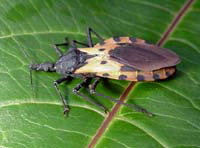
A “kissing” bug.
Excuse this biology lesson, but I think host-parasite relationships (and the evolutionary processes leading up to them) are fascinating. Kissing bugs are large (2-3 cm body length) brown or orange true bugs (order Hemiptera), and are common throughout Central America. They get their name from a habit of biting sleeping people near the mouth. Their other name comes from the fact that they transmit Chagas disease, which is caused by the protozoan Trypanosoma cruzi. The bug tends to defecate as it feeds, and the protozoan occurs in its feces. The bite itches a lot (often for several days), and the protozoa are inadvertently introduced into human blood when the sleeping person scratches feces into the bug bite. The trypanosomes persist in the human blood stream (to be picked up again by future kissing bugs) and cause slow degeneration of the nervous system. There is no known cure. Interestingly, it is believed that Darwin died from Chagas disease. Before you start wondering if I will die from this bite, I should tell you that not all kissing bugs carry the trypanosome, and Chagas is quite rare (perhaps completely absent) in the Monteverde area. Such is not the case in other areas — especially lowland forests — where as many as 80 percent of the bugs are carriers.
On to other topics … I said I would go up a tree today, but the weather was nasty all day and I did not get a chance to climb. The weather here is difficult to predict, but during this time of the year it seems to follow a cycle; several days of rain are usually followed by one or two days of at least partial sunshine. Yes, Monteverde is a pretty gloomy place to live at times.
Another lesson, but one I think is worth mentioning: Seasonality in the tropics is based primarily on rainfall instead of temperature and day length. (Days are always more or less 12 hours long near the equator, and my internal clock struggles through a major readjustment whenever I go back to Olympia, Wash.) In most tropical places, there are distinct wet and dry seasons. Local people refer to the wet season as invierno (winter), and dry season as verano (summer). Monteverde really has three seasons: 1) wet season, which generally occurs from June to November; 2) windy-misty season, from early December to late January; and 3) dry season, from February to May or June. Wet season is obviously a very rainy period. When there is a large low pressure system in the Atlantic — a hurricane, for example — it rains almost constantly in Monteverde for two or three weeks. Everything (clothes, sheets, boots) gets damp during these periods (called temporales) and quite literally develops a life of its own (fungi have a field day).
The windy-misty season is also wet, but more from cloud mist than rain. It gets its name from the trade winds, which drop to a lower altitude during these two months. Because Monteverde exists on top of a mountain with lots of open sea on either side, this is a windy place 90 percent of the year. Trees here generally appear “flagged” — all their branches and leaves grow facing downwind. During the windy-misty season, we get battered by especially strong gusts, and 100 kph (60 mph) sustained winds are the norm. Last year, the winds started tearing the roof off of my house. I spent every morning picking up the pieces and every afternoon putting them back in place with bricks to hold them down. A local carpenter made some repairs for me during the dry season, and I am hoping my humble little home fares better this year.
Dry season in Monteverde more than makes up for the other months. A typical Monteverde day in March is like the best spring day you can imagine in the U.S. The air is clean and fresh (except for dust from the dirt roads), the sun shines virtually every day, the clouds are high and puffy against a crystal blue sky, and the number of stars you can see at night boggles the mind. This is also a time of great cultural activity, with festivals, bull fights, and bicycle tours throughout the region.

That’s me, descending from a tree.
Although I did not climb a tree today, I did prepare one to climb tomorrow or later in the week. When I tell people that I climb tropical trees and collect insects for a (meager) living, their first question is usually, “How do you get up there?” Tropical trees are generally very tall (30+ meters) and have few if any branches below their crowns. The only inexpensive ways to get up a tree are to climb up the trunk like Spiderman, or to string a climbing rope over one or more branches and haul yourself up. I use the latter system. Most tropical tree trunks are too smooth and too great in diameter to climb freehand. Plus, it is not a very safe way to go up (unless you are Spiderman).
Some simple materials and a lot of patience are all that you need to get a rope in a tree. My coworkers and I call this process “rigging.” I start with a slingshot, a fresh spool of fishing line, and a lead or steel weight. Here’s where the patience comes in. The object is to shoot the weight (with fishing line attached) over a solid branch with the slingshot. Much easier said than done. Usually there are multiple layers of leaves in the way, and a clean shot requires hitting a one-square-meter hole in the canopy, directly overhead, at a distance of 30 meters. I have been shooting lines like this for more than seven years, so I can normally hit what I want on the first or second shot. If I fail after three tries, I usually seek another tree or come back at a different time. I am not a superstitious person, but I do think there is some karma involved in this technique.
Today, the weight passed cleanly over a good branch on the first shot and came back to the ground without getting hung up. Fishing line is not strong enough to pull up a climbing rope, so I attached a 4-mm polypropylene cord to the free end of the fishing line and reeled it in — over the branch and back to the ground on the other side. I then tied an 11-mm static rock-climbing rope to the poly cord using a special “nail” knot, which has a low profile and makes it easier to pull a thick rope through branches and debris. I then tied one end of the climbing rope to the base of a nearby tree, and voilà, we’re all set to climb. When I am finished climbing this tree, I’ll leave the poly cord in place of the climbing rope so that we can climb the tree in the future without having to rig it again each time. At present, Nalini and I have over 40 trees rigged like this on the Reserve. I’ll talk about the equipment I use for climbing the rope later.
I hope to get up this particular tree tomorrow. From the ground, it looks like it supports a healthy epiphyte load, and that is what I’m after. I only climb in bad weather when I really need to (in order to stay on sche
dule for data collection). Nothing is pressing right now, so I’ll wait for good weather. Either way, I’ll be in the forest tomorrow and will undoubtedly have some interesting things to tell you about.
Tuesday, 29 Aug 2000
MONTEVERDE, Costa Rica
I looked in the mirror this morning and found seven very itchy kissing-bug welts on my left shoulder. I only recall three bites, so I guess you could say the bug has the adaptive advantage.
It rained throughout last night with plenty of thunder and lightning. I get a real kick out of thunder and lightning — if it is going to rain like hell, it might as well be interesting! This morning was absolutely beautiful, so I went up the tree I rigged yesterday. Before I tell you about what I experienced up there, I want to talk a little about the equipment I use to climb trees and about the biology of this particular tree. (If it is not already apparent, you can count on some kind of lesson every day — I love biology, and I love to teach.)

Prepping for a climb.
The equipment I use to climb up the ropes is pretty basic. I wear a standard rock-climbing harness that is outfitted with a variety of carabiners and slings made of tubular webbing. The webbing and ‘biners enable me to safely climb around on branches, away from the rope. I use a pair of ascenders (also called “Jumars,” which is a brand name) to go up the rope. Each ascender is just a metal handle with a toothed cam inside. The ascender will go up the rope without resistance, but the teeth of the cam grab the rope when downward force is applied. So, it is basically a unidirectional system that allows a person to move along or up a rope without fear of sliding down. I have one ascender tied to my harness, and the other has two loops of webbing for my feet. To go up, I lift my feet and use my hands to slide the foot ascender up the rope. Then I stand up in the foot slings while sliding the other ascender up the rope. I lift my feet again, stand up again, and so on. Just imagine a human inchworm.
Climbing 30 meters up a rope is not as difficult as it sounds. After some practice, it takes about the same effort as climbing 10 flights of stairs. I have taught all sizes of people to do it. Most try too hard at first, and it typically takes them about 30 minutes to go up 30 meters. After some experience (and after the fear subsides), most people can do the same in less than 10 minutes.

A strangler fig from below.
The tree I climbed today is a strangler fig (Ficus sp.). Many people in the U.S. have smaller versions of this tree growing in their homes. I talked a little about epiphytes in my first diary entry. True epiphytes live on top of other plants without a connection to the ground. Strangler figs are called hemi-epiphytes because they start out as small trees growing on top of other trees, but eventually send roots down from the canopy and establish a connection with the ground.
Strangler figs get started when a bat or a bird eats a fig fruit and deposits the seeds in the crown of another tree. The fig sapling grows into a small tree within the crown of the host tree, and its roots grow down the host’s trunk, eventually enveloping the host tree completely. Hence the name “strangler” fig. After may years, the host tree dies and begins to rot, leaving the large hollow fig tree behind. The jury is still out on what causes the host tree to die — it is either literally strangled by the fig, or the dense fig foliage in the crown out-competes the host tree for sunlight. It is probably a combination of the two.
The trunks (old root systems) of figs are convoluted and easy to free climb. The local kids have many favorite hollow fig trees that they climb from within, greatly impressing the tourists when they poke their heads out of the top of the tree trunk.
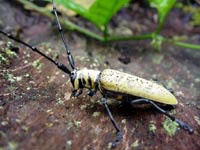
Meet the beetle.
I have climbed more than 200 tropical trees, most of them more than once, for a total of well over 1,000 separate ascents. No two climbs have ever been the same, and I can safely say that I have seen something new each time. Today it was a big (3-4 cm length) long-horned beetle that flew into the crown of the tree shortly after I arrived. I had just secured myself to a branch and unclipped from the rope when I heard the buzzing of a large flying insect headed my direction. There was a big “thwap!” as it landed ungracefully on a leaf about a meter away. I grabbed it so I could photograph it for you. As soon as I picked it up, it started making a high-pitched buzzing sound, which is probably pretty effective at deterring birds and other predators — not to mention that it has big mandibles that can easily cut through skin!
The branches of this tree are completely covered in epiphytes — lots of orchids, ferns, and bromeliads. It also has several woody epiphytes, most of which are related to blueberry bushes. I sat there almost motionless for at least a half hour watching the hummingbirds and bananaquits forage among the epiphyte flowers. There was only a light breeze blowing today, so things were pretty quiet in the tree. In the distance I could hear the howling of howler monkeys and the occasional call of a pair of prong-billed barbets. I saw a group of odd-looking flies hovering among the branches. I’m just guessing, but I think they were males of the same species in competition for the best patch of space to attract females. A fly would hover for several seconds before being attacked by a second fly. An air battle immediately followed, and it reminded me a lot of jousting — each attacker trying to knock the resident fly out of that particular patch of air space. I think I could have watched this go on for hours, but clouds were building on the horizon and I had other things to tend to …

A not-so-itsy-bitsy spider — a tarantula at ground level on a different day.
My purpose in climbing today was to look around for spiders. I have an assistant coming down here soon who will be doing a project related to canopy spider diversity, and I wanted to start thinking about the logistics of such a project before she arrives. Spiders are abundant in the canopy, and are perhaps the most important predators of caterpillars and other insects that hang out in vegetation.
Today, like other days when I’ve searched for spiders, I found surprisingly few. Most spiders are active at night, and I’m pretty certain that we will have to do some night climbing in order to get enough data for the project. I’ve done a few night climbs before, and I can tell you that being in a tree at night is a completely different experience from day climbing. For one thing, you can only see as far as your light. This means that the ground is never in view, and it is very easy to forget how high up you are. Also, there is a completely different fauna active in the canopy at night. A sort of changing of the guard occurs as diurnal animals go into hiding and nocturnal animals come out to feed. I will not be doing any night climbing this week — perhaps in a future Grist diary.
Tomorrow I will be working on the ground in the forest. I’m sure I’ll have plenty to share with you afterward.
It is pouring rain outside again, with plenty of thunder and lightning. A fresh batch of gallo pinto awaits me …
Wednesday, 30 Aug 2000
MONTEVERDE, Costa Rica
A beautiful star
ry sky appeared last night after the storms passed, but this morning was cloudy and a bit chilly. The wind was whipping over the mountain, carrying the clouds with it. To me, clouds coming over the mountain and then disappearing as they descend to lower altitude look very much like waves breaking on the beach, only in slow motion.
I spent most of this morning in the forest with Sr. Rodrigo Solano (Rigo), a Costa Rican (or Tico) who has worked in Monteverde as Nalini’s project manager for over 12 years. I have only known Rigo for a little more than a year, but he is like a brother to me. Before I tell you about my trip to the forest with him, I’m going to skip to the events of this afternoon …

Me and my moto.
Most people use motorcycles or horses to get around in rural Costa Rica. I have never been especially comfortable on either, so I have been bouncing around Monteverde (and sweating a lot!) on my mountain bike for the past year. For various reasons, Nalini, Rigo, and I have started working in some forests that are 20 km or more away from the Reserve. A mountain bike just doesn’t do the trick anymore. So, Rigo volunteered his personal time on the weekends and afternoons to help me find a suitable motorcycle (a.k.a. moto) — mainly so I can efficiently travel from research site to research site, but also to make my life 100 times easier. I have no problem speaking Spanish all day long, but negotiating the purchase of a moto is well beyond my abilities. Enter Rigo. What a trooper! He is so patient with me sometimes, it makes my heart swell.
Anyway, I spent this afternoon talking with a lawyer and the registered owner of the moto that I wanted to purchase. Thanks largely to coaching from Rigo, the transaction was a success, and I am now a happy camper. Rigo and I have a habit of going for long bicycle rides together every Saturday, and I still plan to ride my bike up to the Reserve a few times each week (it is more than three km, all uphill), but having this moto adds a whole new dimension to my life. For example, I can now go see the Arenal Volcano (an active volcano 50 km from here) and other local points of interest whenever I want to, without having to rely on Rigo to get me to such places.
I think there is an important message in this story of how I bought my moto. Consider the situation: I am just a gringo studying insects in Rigo’s country. The data I collect benefit relatively few people, and I feel like I have very little to give back. (This problem has plagued me incessantly for the many years I have been working as a biologist in Central America, and I hope to someday find a creative and useful solution that does not involve money.) Although most Ticos I have met have treated me kindly, this has not always been the case. Many gringos come here to exploit the people or their resources, so negative attitudes are justified in my opinion. No matter where I end up in life, I hope I will always remember and appreciate what Rigo did for me today and earlier this week. I am sure he had to put some national pride aside in his efforts to help me, and I now wonder how many gringos would do the same for a Tico visiting the U.S. Based on the typically arrogant and demanding North Americans who visit Monteverde as tourists, I suspect the number, sadly, is very few.
On to a lighter topic: my morning in the forest with Rigo at the Monteverde Reserve. We started hiking on the research forest trail around 7:15 with a bunch of wooden stakes on our shoulders. The stakes will be used to support a series of 30 buckets, each one meter above the ground. We use the buckets to catch (and ultimately measure) the amount of leaf litter that falls from the canopy in different forest types. Knowing that I would be writing to you later today, I kept my eyes wide open during our hike and tried to see the forest in the same way that I did the first time I entered it. This was not as easy as I thought it would be, but I think I can paint at least the beginnings of a feeble picture.
First off, everything is green. This is a very lush forest, and mosses cover everything, so the greenness can be overwhelming at first. It is much like letting your eyes adjust to darkness, but it takes a little longer. After an hour or so of looking around, it becomes easier to see the incredible diversity of shades of green, as well as the diversity of leaf shapes and plant growth forms that exist in this forest.
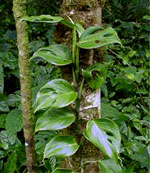
Philodendron, a common “house” plant in tropical forests.
Plants that are common in U.S. homes grow wild here. Dieffenbachia (mostly in the lowlands), Philodendron, Anthurium, Monstera, passion flower, Bird-of-paradise, Peperomia, a great variety of ferns, and many other “house” plants are always within arm’s reach from the trail. In this forest, the plant families Gesneriaceae (gentian relatives), Solanaceae (nightshade relatives, like tomatoes), and Rubiaceae (coffee relatives) are especially common in the understory. If you look a little closer, you see that many plants have galls (abnormal growths caused by insects or mites that live within plant tissues) and scars from the egg-laying activities of cicadas. Also, many of the leaves you see have holes in them — a good indicator of how important herbivory is in tropical forests. However, there are some plant species with 90 percent or more of their leaves undamaged by insects. These plants probably have one (if not several) chemicals in their tissues that are distasteful to insects and other plant-feeders.
About 100 meters down the trail, I smelled something strong and musky very similar to human body odor. This was the scent of collared peccaries — hairy pig relatives that travel in groups through this and many other tropical forests. We did not see the peccaries, but the scent was a clear indication that a group of them had spent the night nearby.
As we walked along, I heard the various calls of slaty-breasted wood wrens coming from the surrounding vegetation. These are the most common understory birds in the Monteverde forest, and they make two general types of sounds. The first is a pleasant, fluty sing-song melody typical of wrens, and the second (for aggressive situations) is a repeated harsh rasping sound. I also heard one of my favorite calls — that of the slaty-backed nightingale thrush. This is a five-note call that goes up and then down in pitch. It sounds more like it is coming from a synthesizer than from an animal, with the last note very much resembling microphone feedback. Of course, the somewhat spooky roar of howler monkeys could also be heard coming from a distant part of the forest.
At one point along the trail, Rigo dropped his bundle of stakes (these things are heavy and the terrain is rough), and picked a small white flower up from the ground. He gave it a quick smell, handed it to me, pointed at one of the trees above us, and rattled off its scientific name and family name as if he used it in conversation every day. The flower smelled great, but the really impressive thing is that Rigo can identify virtually everything he sees in the forest. This is true of many Costa Ricans I have met, most of whom (like Rigo) have no more than a high school education. How many of your friends with higher degrees can identify the species in their region? Maybe I am just quirky, but I think there is something fundamentally important, and noble (for lack of a better word), in being able to recognize the diversity of life in your surroundings. I could go on forever about this topic, but it is getting late, and I guess I would only be preaching to the choir anyway.
Rigo and I will be working in the same section of forest again tomorrow. I’ll keep my eyes open for you …
Thursday, 31 Aug 2000
MONTEVERDE, Costa Rica
Last night, a few minutes after I emailed my diary entry to Grist, an owl flew onto my porch, grabbed something, and flew off — all in the blink of an eye. I am not sure what it caught, but I assume it was a mouse. Mice are like cockroaches with fur. (Although I am an entomologist, I am not fond of domestic cockroaches.) I can sleep through strong winds and torrential rains battering my tin roof, but the sound of mice running through my walls keeps me awake all night. Believe me, a little natural predation around here is very welcome. At times, I have even considered snatching a large boa constrictor from the forest to use as mouse control.

A really big mosquito.
Today was a great day to be in the forest — the air was calm and cool, and no major rains came until the afternoon. Also, Rigo and I stumbled across more animals than usual today. Mosquitoes and horseflies were by far the most numerous critters we encountered (I have lots of bites to prove it), but this is typical for the wet season here. We also saw a black-faced solitaire perched on a vine over the trail. These birds are pretty common at this elevation, but I rarely see them and none have been calling recently. The solitaire call is two long notes that, like the notes of the nightingale thrush I mentioned yesterday, sound a lot like microphone feedback.
I also heard the call of a three-wattled bellbird. The males of this pigeon-sized, brown-and-white bird have three black fleshy things (wattles) hanging off their heads. I never saw the bird, and one rarely does when standing inside the forest — they generally perch on the tallest twigs of the very top branches of canopy-level trees. The bellbird call is an occasional, very loud “BONNNK!” which can be heard for several kilometers. The one I heard today is a bit of a late bloomer; males typically do most of their calling during the dry season.
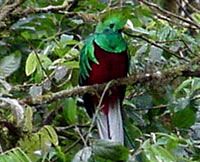
A male quetzal.
Resplendent quetzals are another bird that is most commonly seen in the dry season, but we stumbled upon a pair in the forest today. (Of course, it was Rigo who spotted them first.) Both male and female are bright iridescent blue and green, about one and a half times the size of a robin. The male also has a bright red breast (not red like a robin’s breast — I mean really red) and very long (30 cm or more) iridescent green tail feathers. They have a fluty, almost owl-like call, but breeding season passed months ago and none are calling now. The male of this species is certainly one of the most beautiful birds in the Western Hemisphere.
We also saw two snakes today. The first was a brown relative of garter snakes that hangs out in the leaf litter. They are very common, and I frequently see them sunning themselves on the path to my house. This snake does not move especially quickly, but it is surprisingly difficult to keep your eye on one when it is in the litter (mostly because this species doesn’t have a conspicuous pattern). The second snake we saw was a chunk-headed snake (Leptophis sp.), which is mostly brown with tan splotches on its back. Its body is pencil-thin, but its head is the size of your thumbnail (hence the name). Chunk-headed snakes are laterally flattened (almost fish-like), with special scales on the edges of their bellies that enable them to climb even relatively smooth tree trunks and branches. They specialize on tree frogs for food.
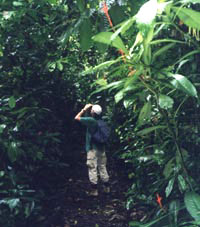
Here I am, checking out the forest.
We did not smell or see peccaries in the forest today. Although I made a special effort to note any odd smells, I have none to report. The air just smelled clean and fresh to me, as it usually does in the forest. Except for the ever-present howler monkeys and squirrels, we did not see any exciting mammals today. However, we did find tracks of a large cat in the mud along the trail. I have never seen any wild cats here, but they are definitely around. We see tracks of jaguarundi, pumas (mountain lions), margays, and/or ocelots almost every time we go out.
Rigo and I saw a lot of other interesting things in the forest today, but I’ll end up writing forever if I do not stop here …
This is my final diary entry for the week. If you are still interested in the ecology of tropical forests and forest canopies after wading through all of my text, then there are several ways to get more information. First, you can join ICAN — the International Canopy Network. ICAN has a special feature called Ask Dr. Canopy, which is an appropriate mechanism for you to get answers to very basic questions about canopy biology. Most submitted questions are from children, but don’t let this deter you. ICAN also has a canopy email list server, but I should give you fair warning that most of the postings to the list are technical comments between scientists.
Another site that may interest you is Cloud Forest Alive. Many of the photos posted on this site were taken near my Monteverde office by Jason Roberts, who manages the site. Jase has lots of high-tech equipment that he uses to photograph nesting quetzals and hummingbirds visiting a feeder outside his office window. There may still be a photo of a quetzal posted at this site, although nesting season ended two months ago. Jase might even be willing to send you a quetzal photo if you email him at info@cloudforestalive.org — tell him I sent you.
Second, you can ask me directly via email at yanoviak@racsa.co.cr if you have questions specific to what I have written or what I am doing in Monteverde.
Finally, there are several good books — both technical and popular — that deal with rain forest ecology and canopy ecology. My No. 1 picks for general tropical ecology are: A Neotropical Companion, by J. C. Kricher; Tropical Nature, by A. Forsyth and K. Miyata; The Tropical Rain Forest, by P. W. Richards; Monteverde: Ecology and Conservation of a Tropical Cloud Forest, by N. M. Nadkarni and N. T. Wheelwright; and An Introduction to Tropical Rain Forests, by T. C. Whitmore. Some descent books about forest canopy ecology include: Life Above the Jungle Floor, by D. Perry; The High Frontier, by M. Moffett; Forest Canopies, by M. Lowman and N. Nadkarni; and Canopy Arthropods, by N. Stork, J. Adis, and R. Didham. The quality of writin
g is marginal in the first two of these books, but they do contain some amazing photos. The latter two are aimed at a fairly technical audience.
In my idealistic (and equally cynical) view of the world, I expect people to become educated about their surroundings. I firmly believe that education, especially outdoor education, is key to the successful coexistence of future human generations with their environment. As E. O. Wilson so thoughtfully pointed out in his book Biophilia, humans are born with a fascination for nature. Scientists, activists, and environmentalists need to tap into this innate appreciation with greater effectiveness. Again, education is the key.
Sharing my thoughts and experiences this week has been a great pleasure for me. I sincerely hope that you have also enjoyed it, and most of all, that you learned at least one new thing along the way.


